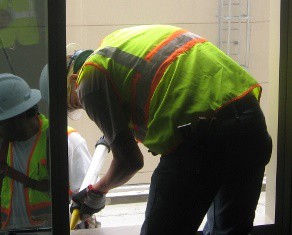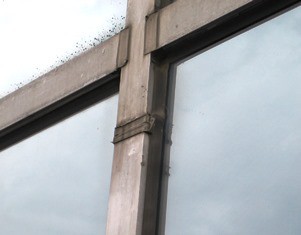HELP! My Windows Are Leaking!

"HELP! My Windows Are Leaking!" by: Dale Fuhr, CDT, Associate Principal, Wiss, Janney, Eltsner Associates, Inc.
Most of us have received these cries for help. What are our options?
When buildings first begin to experience air and water infiltration through their exterior window systems, owners and management firms are typically faced with the following three options:
Option #1 - A complete window system replacement approach. This option is generally only considered in rare cases where the window systems have reached such a poor condition that the aesthetics, air and water performance, and in some cases the structural integrity of the system, has been significantly compromised. Another reason for considering a complete replacement is when the energy performance of the system is less than desirable. A common example of this circumstance would be an older building with monolithic glazing that is also experiencing air and water infiltration issues.
A complete replacement will cause a major disruption to the building occupants and their daily operation. Typically, it will also cause some degree of remediation to the associated interior finishes and surrounding substrates. If the correct replacement system is selected, properly installed and maintained, it should provide an additional 25 to 40 years of anticipated service life and a much improved energy performance. It should be noted that compliance with the existing energy code would be required.
 Option #2 - A gasket and weatherseal replacement approach (Figure 1). If the system is glazed from the exterior, the use of access equipment would be required to accomplish this option. It would require removing the glazing stops or snap caps and pressure plates so that the glass can be removed for inspection of the suspect internal framing joints, water diverters and zone dams. All failed conditions should be properly cleaned and resealed in conformance with the sealant and window/curtain wall manufacturers written recommendations. Based on the exterior gaskets long term exposure to ultraviolet (UV) light, they typically dry out, shrink, and harden over time. This reduces their compression capability and often allows a higher volume of water into the glazing pockets than the system was originally designed to manage and weep to the exterior. While it may not be necessary to replace the interior gaskets that were not directly exposed to the UV, it is important to measure all of the related components - glazing pocket, glass thickness, interior gasket and exterior gasket thickness and durometer - to assure that the combination of these components will achieve the original minimum design goals. It should also be noted that most Insulating Glass Unit (IGU) manufacturers have established guidelines for the maximum allowable gasket compression limit at the edge bands. If these are exceeded, it may affect the IGU warranty. Thus, arbitrarily selecting the thickest gasket that can be forced into a system may cause more harm than good.
Option #2 - A gasket and weatherseal replacement approach (Figure 1). If the system is glazed from the exterior, the use of access equipment would be required to accomplish this option. It would require removing the glazing stops or snap caps and pressure plates so that the glass can be removed for inspection of the suspect internal framing joints, water diverters and zone dams. All failed conditions should be properly cleaned and resealed in conformance with the sealant and window/curtain wall manufacturers written recommendations. Based on the exterior gaskets long term exposure to ultraviolet (UV) light, they typically dry out, shrink, and harden over time. This reduces their compression capability and often allows a higher volume of water into the glazing pockets than the system was originally designed to manage and weep to the exterior. While it may not be necessary to replace the interior gaskets that were not directly exposed to the UV, it is important to measure all of the related components - glazing pocket, glass thickness, interior gasket and exterior gasket thickness and durometer - to assure that the combination of these components will achieve the original minimum design goals. It should also be noted that most Insulating Glass Unit (IGU) manufacturers have established guidelines for the maximum allowable gasket compression limit at the edge bands. If these are exceeded, it may affect the IGU warranty. Thus, arbitrarily selecting the thickest gasket that can be forced into a system may cause more harm than good.
It should be noted that this option can be intrusive to the building occupants and can be inhibited by interior finishes and furniture, especially if the system is glazed from the interior. The combination of replacing the aged or failed gaskets and remediating the internal sealants should extend the performance life of the existing system an additional 15 to 20 years. When completed, there should be limited if any visual evidence that the remediation effort ever occurred. Thus, the system looks the same as prior to the remediation, but its performance capability has been greatly increased.
 Option #3 - The “wet seal” remediation approach (Figure 2). The common understood meaning of “wet sealing” in the building enclosure industry is the act of applying sealant between all metal-to-metal joints and metal-to-glass joints within a glazed window or curtain wall system. This effort transforms the glazing system from a drainage system to a barrier system. This is the option that has become the norm when an owner is faced with a glazing system that is exhibiting air and water infiltration related issues. Often the decision to wet seal is made for not only budget reasons, but to also minimize the disruption to the building occupant’s routine operation. Sadly, it is not uncommon for this decision to be made without truly investigating and determining the actual cause of the leaks.
Option #3 - The “wet seal” remediation approach (Figure 2). The common understood meaning of “wet sealing” in the building enclosure industry is the act of applying sealant between all metal-to-metal joints and metal-to-glass joints within a glazed window or curtain wall system. This effort transforms the glazing system from a drainage system to a barrier system. This is the option that has become the norm when an owner is faced with a glazing system that is exhibiting air and water infiltration related issues. Often the decision to wet seal is made for not only budget reasons, but to also minimize the disruption to the building occupant’s routine operation. Sadly, it is not uncommon for this decision to be made without truly investigating and determining the actual cause of the leaks.
Typically, the decision to begin installing wet seals is made in an attempt to mitigate isolated leaks that require some level of remediation. Gradually, as the random leaks become more global, the owner or building management firm is confronted with the decision whether to continue the more costly “one at a time” installation of wet seals or to simply wet seal the entire glazing system at one time. One of the benefits to a global wet seal approach is that a warranty for the materials and labor can typically be attained. The glazing, waterproofing, and consulting industries have elected to utilize many different approaches as to how, and to what extent, wet sealing should be applied. Since there are numerous glazing systems and surrounding substrates that must be considered when designing the correct wet seal repair method, persons not intimately knowledgeable of the nuances of each of the glazing systems and how they actually drain or weep are often at a design disadvantage. Considering whether or not to leave an exit path for future water that may bypass a poorly installed wet seal or a de-bonded location is also a subject that is addressed differently by many within our industry.
One of the often overlooked aspects of designing the appropriate wet seal method is how the completed work will impact the aesthetics of the window system. It is not unusual for an owner or building management firm to be somewhat surprised by the final look. Preparing a visual mock up should be considered. Typically, the method of sealing the metal-to-metal joints creates the largest visual concern. In some cases consultants require the use of pre-cured silicone tape in lieu of wet silicone over these metal-to-metal joints. Other critical decisions include whether the existing exterior gaskets shall be completely removed and a silicone compression rod or wedge gasket (without a lip) be installed and then the silicone sealant be applied between the glass and metal, or do they simply trim off the gasket lip and install the silicone sealant directly over the remaining portion of the gasket. When making this decision, consideration should be given as to the material, age and shape of the existing gaskets. With aged EPDM gaskets there is less likelihood of a bleed-through of the petroleum-based substances than with newer gaskets as they have dried out over time. This bleed-through typically results in a slightly orange look. When hollow shaped gaskets are trimmed, it can result in a loss of compression against the interior gasket. This would not pose a significant problem if the interior gasket is pre-set (with a dart in a framing raceway); however, if the interior gaskets are a wedge-type gasket, the loss of compression could result in the interior gaskets becoming disengaged and continually falling out of the opening. This is more of a maintenance issue that a performance issue. If the wet seals are properly installed and maintained, it should provide an additional 10 to 15 years of service life.
Regardless of the remediation method selected, it is prudent to prepare and test a representative mockup of a completed specimen. There are several options of testing that can be considered. The most stringent test method is the ASTM E-1105 Field Determination of Water Penetration of Installed Exterior Windows, Skylights, Doors, and Curtain Walls, by Uniform or Cyclic Static Air Pressure Difference, and the ASTM E-331 Water Penetration of Exterior Windows, Skylights, Doors and Curtain Walls by Uniform Static Air Pressure Difference. These test methods require the sealing of a chamber to either the interior or exterior face of the specimen to apply a differential pressure across the specimen, in order to test the water resistance capability of the system. Due to access challenges it is more common for the chamber to be installed and sealed to the interior face with the water spray rack located at the exterior face of the specimen. There is much debate within the consulting community regarding the appropriate test pressure to be used when conducting these tests on either original or remediation projects. The test pressures most often specified are two-thirds of the original glazing system design pressure. The other, and more stringent requirement typically specified would be to test the system at the full design pressure. Both of these test methods typically require some demolition of interior finishes.
Another test method that is often utilized is the AAMA 501.2 Quality Assurance and Diagnostic Water Leakage Field Check of Installed Storefronts, Curtain Walls, and Sloped Glazing Systems. This testing is conducted using a Monarch spray nozzle and applying the water at a rate of 30 to 35 psi. This test method is commonly referred to as “hose testing.” This test method is conducted from the exterior and observed from the interior for evidence of leakage with no pressure differential applied across the specimen.
All of us should realize that we are partners in the effort to provide owners with buildings that can continue to perform well beyond their original service life expectancy. The important aspects to consider when attempting to address an air and water infiltration problem within an existing window or curtain wall system should be to first confirm the leaks originate within the glazing system. If the leaks are observed to be originating within the glazing system, then the above options should be discussed with the owner’s representative. Providing an owner with an estimated budget as well as a list of the project specific pro’s and con’s for each of the options would allow them to make the best possible decision for their circumstance. Then, all we have left is the simple task of performing our individual roles to the very best of our ability!
Following 36 years working in all aspects of the contract glazing industry, including owning his own firm for 10 years, Dale Fuhr joined Wiss, Janney, Elstner Associates, Inc. (WJE) as an Associate Principal in 2007. His previous roles as installer, project manager, estimator, operations manager and owner for several contract glazing firms has proven to be a great asset to WJE. His primary client services include design assistance, specification development, peer reviews, construction administration, forensic investigation, testing and litigation support related to glazing and wall panel systems. His unique background also allows him to assist WJE’s clients with cost/budgets, construction sequence and means and methods analysis. Dale can be reached at dfuhr@wje.com or by phone at 832-467-2177
Subscribe Today!
Stay-in-the-know and subscribe to our blog today!